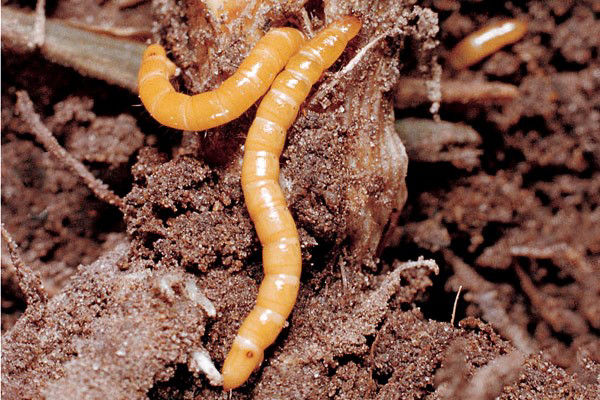Watch for Wireworms Damage in Corn
December 13, 2018

Often considered a secondary or occasional corn pest, wireworms are more likely to attack fields that have previously grown sod, pasture or small grains or have a history of wireworm damage. Wireworms can be damaging to corn crops worldwide, particularly in the more moderate climates that exist across most of the United States.
Identification and Lifecycle
Slender and hard-bodied larvae give the wireworm its descriptive name. They are shiny, yellow to brown in color and range in size from 1/2 to 1 1/2 inches long. Because the lifecycle of certain wireworm species may be from four to seven years, larvae may damage several consecutive corn crops.
Adult wireworms are click beetles and do not cause damage. They make a clicking sound when they try to turn over after falling and landing on their backs. In the spring, click beetles lay tiny, white, round eggs in the soil, most commonly around grassy weeds or crops. Larvae survival corresponds with favorable food sources, temperatures and moisture.
Wireworms move upward in the soil during moderate temperatures but burrow farther down when weather is very hot or cold. Mature larvae pupate in the upper 4 inches of the soil in the spring.
Crop Damage
Wireworm larvae pose a problem for farmers because they feed on corn kernels and destroy the inner portion, leaving only the seed coat. This damage is most easily observed in gaps between corn rows. Further crop injury occurs when wireworms eat small roots and make underground tunnels to infest roots and stems of corn seedlings. When this happens, corn seedlings are stunted and wilt first appears in the whorl.
First-generation wireworms don’t cause significant damage. Farmers need to be concerned about the following crop years when wireworms feeding on corn seeds and roots pose an economic threat.
Scouting
Scouting before planting is a good preventative control measure because wireworm damage typically turns up after planting, when the timing for some effective management options has passed.
One method to easily scout for wireworms involves using a bait trap one week or earlier prior to planting. Bait traps, however, may not detect low densities of wireworm populations, so it’s still important to scout after corn emerges. Use sampling and insect identification to know if insect pests such as wireworms are in the field and whether or not they will threaten yields and profits. Problems in high- or low-infestation spots may be related to soil conditions, herbicide injury or invasions by other insects.
Wireworms attack corn by underground feeding. If you see seedling damage, dig into the soil around the plant. This will help you identify the pest and determine if it is wireworms or, possibly, white grubs. Scan the field while walking from one site to the next. Look for patterns and variations across the field. If insects and damage are not easily identified, consult county Extension personnel or a pest identification guide.
Best Management Practices to Control Wireworms in Corn
In no-till or limited-till situations, wireworms may become established in the soil, overwinter and feed on newly planted seedlings. Risk of wireworm attack can be greatly reduced by tillage, seed treatments and insecticides, as well as herbicides applied preplant or at planting to knock down vegetation.
Wireworms may be a more significant problem on land that has been converted into field crops from CRP or on pastureland that has grown grasses for longer than a year. In such situations, good control of grassy weeds prior to planting is advised.
The best approach to managing wireworms in corn is preventive control. Starting off with a good seed treatment is an excellent way to control insects and protect corn plants above and below the ground.
Insecticides
Insecticide treatment at planting may be necessary when wireworms are already established and vegetation cannot be destroyed before planting. A good wireworm control option for growers is Baythroid® XL insecticide. The pyrethroid insecticide performs on a broad spectrum of corn insect pests, with fast knockdown and long residual control. Keep in mind there is no rescue treatment to control wireworms after planting. Apply in the furrow with fertilizer or spray as a band over the open furrow to maximize coverage of the root zone. If you see wireworm damage during the growing season, take appropriate steps to manage for next year.
For more information about Baythroid XL or other insecticides from Bayer, please contact your local Bayer representative.
Always read and follow label instructions. Not all products are registered for use in every state. Baythroid XL is a Restricted Use Pesticide.